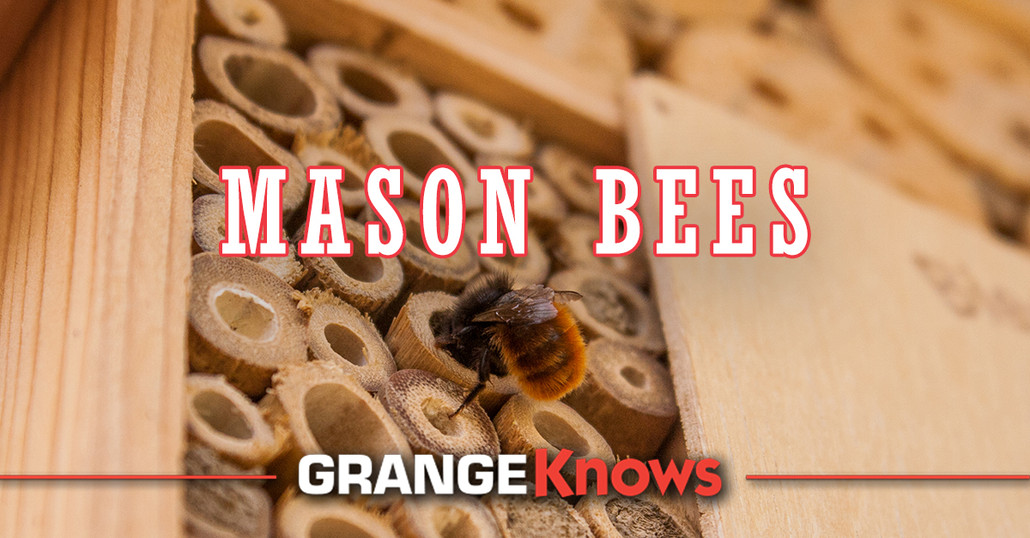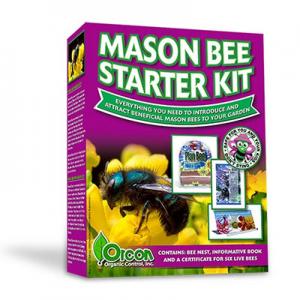
Mason Bees - Attract and Maintain these Pollinators
Posted by Grange Co-op on 11th Jan 2019
In this GrangeKnows article, you’ll learn how to raise and care for one of the most efficient pollinators available: Mason Bees. The benefits of Mason Bees are extraordinary in comparison to the resources needed to maintain these mighty pollinators. Learn just what it takes to maintain Mason Bees and the benefits of keeping these around your home in this GrangeKnows article.
Pollinators help sustain our future food supply and preserve a healthy ecosystem through the process of pollinating our plants. You can do your part to increase pollination in your garden or yard with Mason Bees. Out of the world’s bee species, Mason Bees make up about a quarter. They are one of the most astounding bees; one Mason bee can do the pollinating work of 120 honeybees!
DIFFERENCES BETWEEN HONEYBEES AND MASON BEES
 Raising a hive of honeybees can be a task reserved for the fervent few. However, Mason Bees are much cheaper to start and require less work than a traditional honeybee hive. They are easy to maintain in one’s backyard or garden, nest in pre-made holes, and hibernate in their own waterproof cocoons. Mason Bee’s nesting sites also provide habitats used by other native bees.
Raising a hive of honeybees can be a task reserved for the fervent few. However, Mason Bees are much cheaper to start and require less work than a traditional honeybee hive. They are easy to maintain in one’s backyard or garden, nest in pre-made holes, and hibernate in their own waterproof cocoons. Mason Bee’s nesting sites also provide habitats used by other native bees.
Unlike honeybees, Mason Bees are not social bees, they don’t make honey, live in a hive or have a queen to protect, making them generally gentler and less aggressive—stinging only as a last resort. The venom they release to sting is very mild, which makes Mason Bees a great alternative to honeybees for those who are allergic. Because they’re so docile, protective gear is not necessary when handling the cocoons. The Mason Bee housing materials take as little as 15 minutes to set up and can be purchased online or in-store at your local Grange Co-op. Once the bees house is set up, and they are released, they immediately get to work gathering pollen and laying eggs.
Honeybees wet the pollen they gather and stick it on their hind legs to transport to the hive. They also clean themselves after each visit to a flower, losing about 90% of the pollen they had. Alternatively, Mason Bees carry pollen on the underside of their extremely hairy abdomens. They cross pollinate by visiting a variety of flowers and trees prior to returning to their nesting holes. The hair on their bellies pick up the pollen, but because it is dry it also falls off easily, scatter-pollinating plants along the way.
RAISING A SOLITARY BEE
Grange Co-op carries
Mason Bee cocoons available for purchase for a short window beginning in late-January until early spring. Mason Bees are active in colder temperatures, making them very effective even during the chillier months of year. Grange Co-op also sells starter kits, containing everything needed to introduce and attract Mason Bees to your garden. 
When installing your Mason Bee Starter Kit, look for a south or east facing spot to ensure they receive morning sunlight, as this will warm them up and give them a boost of energy. Mount your nest on a fence, wall, or side of a building, but avoid spots under swaying branches, as the bees don’t like dappled shade and avoid placing near any birdhouses.
Once you have the proper housing set up for Mason Bees to live in, it’s important to create an environment they can sustain themselves in. Mason Bees are most attracted to native plants. When choosing flowers and plants for your garden, pick not only a variety of plants, but those that will bloom at different periods of time. The bees will need pollen throughout their active season, purchase plants that bloom in the spring, others that will bloom in the summer, and even some that won’t bloom until late summer or fall, if possible. Talk with a Grange Gardening Expert to find the perfect array of plants for this purpose.
Mason Bees also need clay-rich, moist soil to survive. They use this soil to protect their egg chambers. Generally, you can see the bees hovering over the ground looking for soft clay to carry back to their cocoons. If you see this behavior, turning up even a small portion of dirt can provide them with enough to build.
Just like any other type of wildlife, avoid using harsh chemicals. All bees rely on their sense of smell to navigate. Chemicals can confuse them, or worse, you could inadvertently kill them with the toxic spray.
MASON BEE LIFE CYCLE
Upon hatching in early spring, Mason Bees immediately begin searching for their food source: pollen and nectar. Next, they search for a home, as the female Mason Bees get to work laying their eggs. To do so, the females bees search for a tube or cylinder—such as lake reeds or bamboo tubes—this is called a nester tube. The females will deposit some clay deep inside the nester tube, along with some pollen and nectar for food, and begin creating a cell where they lay an egg where their young will hatch. It is because of these individual wall buildings that they first received their name: Mason Bee. The female will continue laying eggs through June when they then begin dying. However, it is around this time that their eggs start hatching and eating the food that was left for them. The larvae develop inside their individual cell until August, at which point they spin a cocoon, and finish developing into adults.
While they may be tiny, they are nothing short of mighty. Mason Bees are a simple contribution to the environment, improving pollination and the ecosystem. You have a part to play in the pollination of your community. Purchase your very own Mason Bee cocoon; availability is limited. Speak with a Grange Expert for more information and how we can help you get started with your bees!
References: Mason Bees: One of Nature's Gentlest Spring Pollinators. (n.d.). Retrieved January 8, 2019, from https://thehoneybeeconservancy.org/why-bees/mason-bees/
